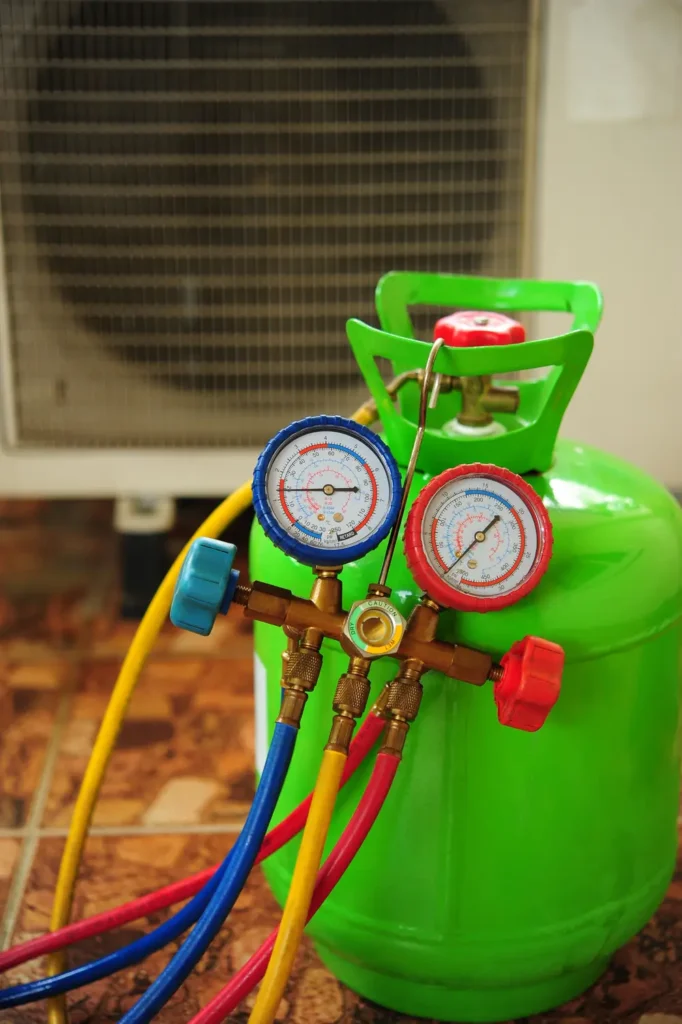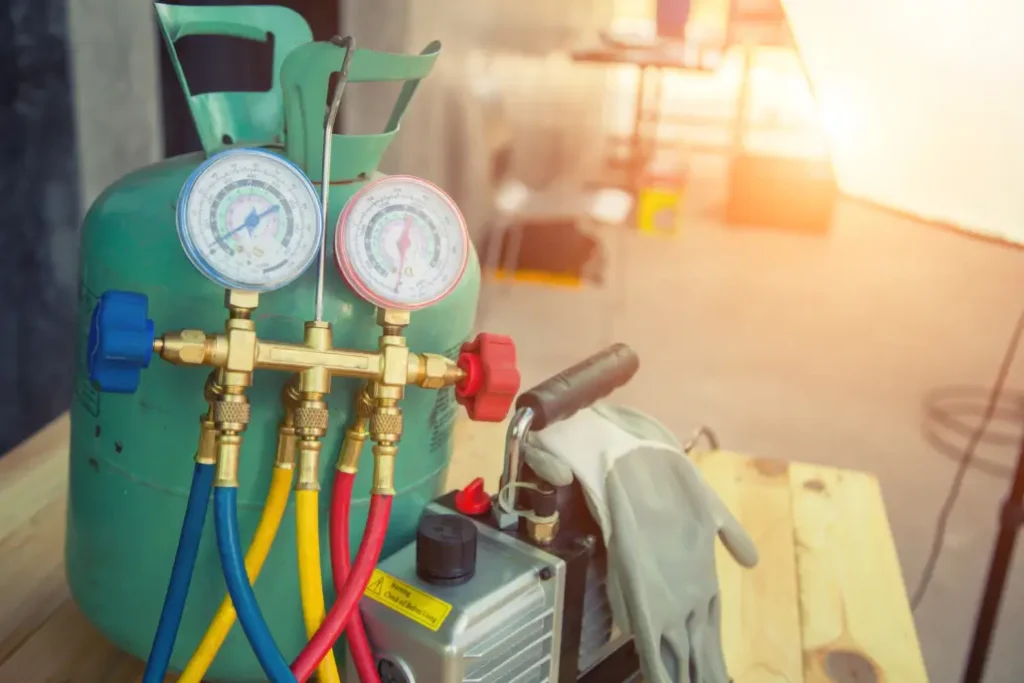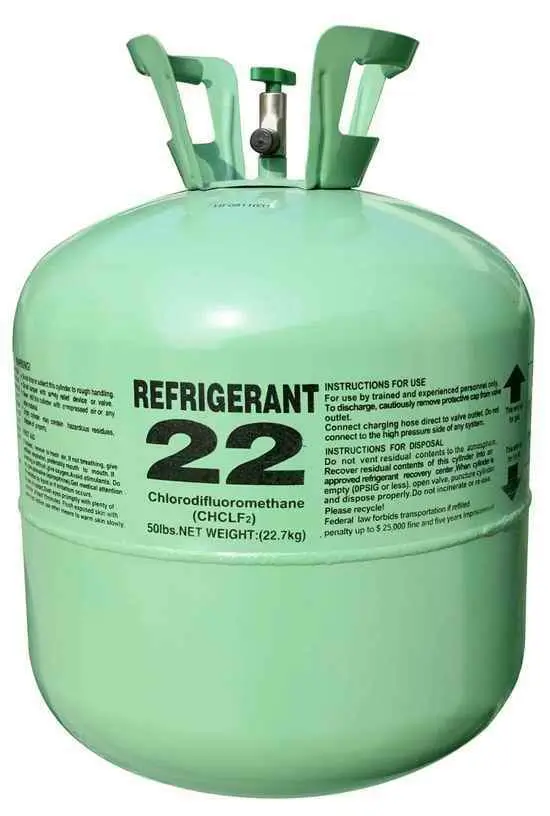Introduction
Refrigerant is the lifeblood of HVAC systems. It is just as vital in an HVAC system as a furnace or air conditioner is. Without it, the cooling process of an HVAC system would not exist.
While it is easy to say that refrigerant is necessary for an HVAC system, it doesn’t explain what it is or how it works. It also doesn’t outline the different types of refrigerants or their common problems. In this blog post, we will be covering all those questions and more. If you have any questions after reading this blog post, let us know, and we will try our best to answer them in the comments below. Let’s dive in!
What Is Refrigerant?
In previous blog posts, we briefly talked about what refrigerant is. In our “What Causes an AC Compressor to Stop Working,” blog post we defined it as “a set of chemicals that are vital to the cooling process.” While this is true for a broad definition of refrigerant, it can be a little bit more complex.
Refrigerant has several definitions because it does many things. Carrier defines it as “a chemical compound capable of transitioning from liquid to gas and back again.” Refrigerant must be able to change states repeatedly without failure. Pressure is constantly applied to it to generate heat, and then said pressure is taken away to restart the refrigeration cycle. Heat must be added and then removed. No matter what definition of refrigerant a person chooses, a refrigerant’s purpose will always be to cool a home.

How Does Refrigerant Work?
While the short definitions of refrigerant give decent explanations of how it works, they don’t explain the whole picture. The longer explanation of how refrigerant works inside an HVAC system is a bit more complicated.
Refrigerant flows through the main components of the HVAC system: the compressor, condenser, metering device, and evaporator. It is constantly changing states and cycling through the system.
Listed below are the stages refrigerant goes through:
Evaporation
Refrigerant travels from the evaporator to the compressor through the suction line. Inside of the evaporator, the evaporator coil absorbs heat from the air and raises the temperature of the refrigerant. The refrigerant changes from the liquid state to the gas state.
It then leaves the evaporator as a saturated vapor at a low pressure and temperature. The suction line increases the pressure of the refrigerant by forcing it to occupy a small space.
Compression
After going through the suction line, the refrigerant arrives at the compressor. It enters the compressor as a superheated vapor at a high pressure and temperature. The compressor takes in the already pressurized refrigerant, pressurizes it even more, and increases its temperature. The refrigerant, by being pressurized, is actually compressed which is where the compressor gets its name from.
Condensation
After going through the compressor, the now liquid refrigerant moves through the discharge line into the condenser. It passes along tubes of the condenser as fans blow across the tubes. The condenser rejects the heat and thermal energy is removed from the refrigerant. During this process, the refrigerant must be at a higher temperature than the air surrounding it. The greater the temperature difference is, the easier the transfer will be. The refrigerant cools and becomes a condensed liquid before going through the liquid line.
Expansion
Through the liquid line, the refrigerant moves towards the metering device, which typically consists of an expansion valve or piston. Old air conditioners or low-efficiency ones commonly use pistons. The metering device reduces the pressure and temperature of the refrigerant. As the temperature drops, the refrigerant begins to boil. It then heads back into the evaporator to repeat the cycle.
Some HVAC systems include an expansion line, where the refrigerant passes before entering the evaporator. Expansion lines are mostly found in ductless systems, however, and not in traditional ones.
The Refrigerant Cycle Is a Loop
The process of how refrigerant works can seem daunting, but half of the reason why it is so complex is that it can be incredibly efficient. It circles through the air conditioner, changing from the liquid state to the gas state over and over again. It has to do that in a relatively short amount of time.
Since the refrigerant cycle is a loop, the stages above aren’t necessarily set in stone. For example, expansion may be shown as the first stage instead of evaporation in other explanations. Refrigerant goes through all of these stages continuously.
At the end of the day, the first definition of refrigeration still stands: refrigerant works by absorbing heat through the air, travels through coils on the inside and outside of the air conditioner, and repeats the process all over again. No matter how complicated the refrigeration process is, it will always fulfill its purpose.

Different Types of Refrigerants
There are many different types of refrigerants, but some are more common than others. For example, Freon is often referenced when talking about refrigerants, but it is not the only one. Listed below are some refrigerants that are frequently used or referenced. While this doesn’t include all the refrigerants used in modern times, it does contain a few and gives a brief overview of the history of refrigerants in the HVAC world. While refrigerants may vary, their purpose always stays the same.
Water
While not commonly mentioned, water is the oldest refrigerant to date. It has several properties that make it desirable to use as refrigerant such as that it’s non-toxic, non-flammable, renewable, and inexpensive to use. It is still used as a refrigerant in evaporative coolers to this day. Evaporative coolers are an alternative to traditional HVAC systems and don’t use electricity. They work by passing outdoor air over pads soaked in water, causing the water to evaporate into the air.
Water is easily available and inexpensive to use, but its boiling and freezing points are too high for it to be a reliable refrigerant. Water boils at 212°F and freezes at 32°F, which are not only considered high temperatures for refrigerant but are also drastically different, making it difficult for water to change states easily. While water can work as a refrigerant, it is not the most efficient option on the market, which is why it is rarely used in modern cooling devices.

Freon (R-22 Refrigerant)
Thomas Midgley Jr. and his team created Freon, a brand of refrigerant, in 1928. To date, it is the most commonly seen refrigerant in HVAC systems in commercial and residential buildings. The boiling point of Freon is -41.44°F. While this number can vary, it generally stays in that range.
In 2020, the United States began to lead a global movement to phase out Freon (R-22) and replace it with Puron (R-410A). The United States no longer produces Freon due to the harmful effects it has on the environment. Freon is slowly being phased out and will not likely be used in HVAC systems in the future.

Puron (R-410A. Refrigerant)
Invented in 1991, Puron has gradually replaced Freon. It operates at a higher pressure than most refrigerants, requiring parts specifically designed for its use. Its boiling point is -55.3°F., and its freezing point is -247°F. Of course, these numbers aren’t set, but Puron’s boiling and freezing point usually stays around those ranges.
Unlike earlier refrigerants, Puron does not deplete the ozone layer, making it a more environmentally friendly choice. However, it still has a high global warming potential. Additionally, Puron is also not 100% safe to handle. Puron is being phased out in favor of Puron Advance.
Puron Advance (R-545B Refrigerant)
Created by Carrier to replace Puron, Puron Advance has a significantly lower global warming potential and meets the standards of the Environmental Protection Agency (EPA). Puron Advance is designed to help reverse, or at least reduce, the effects of climate change. Carrier believes transitioning from Puron to Puron Advance should be relatively easy.
The biggest difference between Puron and Puron Advance—aside from the lower global warming potential—is that Puron Advance is more flammable. However, this shouldn’t be a huge safety hazard as Puron Advance is still less flammable than propane and natural gas. Carrier also plans on adding safety features to HVAC systems that will use Puron Advance.
Some other worthy refrigerant mentions are Isobutane (R-600A refrigerant) and propane. While Isobutane has a low chance of depleting the ozone layer and low global warming potential, it is highly flammable and can explode. Much like the other reasons Isobutane is a risk, propane is a good refrigerant, but it is not often used because it is also highly flammable.
While refrigerants may differ in composition, boiling, and freezing points, they all serve the same purpose. Some of them are just safer than others and more environmentally friendly. As time goes on, the HVAC industry is constantly evolving and searching for the best refrigerant for HVAC systems. Refrigerants will continue to be phased in and out as the search continues for the most efficient and environmentally friendly one possible.
Common Problems
In previous blog posts, we’ve discussed issues relating to refrigerant because it plays such a crucial role in HVAC systems. A lot of refrigerant problems can occur at the same time, as one issue often leads to another.
For example, a refrigerant leak can lead to low refrigerant, which can then cause freezing. It’s a domino effect in some cases, though not all. In this section, we will be talking about how these problems develop and what to do when they do.
Leaking Refrigerant
The most common problem related to refrigerant is leaking refrigerant. A refrigerant leak can lead to multiple issues, such as higher electricity builds, odd noises coming from your air conditioner, increased humidity in your home, reduced efficiency of your AC unit, and freezing and low refrigerant, as mentioned above.
Holes or cracks in the coils or an air conditioner’s old age can cause leaking refrigerant. When refrigerant is leaking, the best thing to do is isolate the problem and call an HVAC technician. To isolate the problem, examine the evaporator or condenser coils and look for any holes or cracks. If there are visible holes or cracks, make a mental note of where they are. The more information the HVAC technician receives about the problem, the easier it will be for them to get the air conditioner’s refrigerant levels back to normal and the HVAC system working better overall.
Low Refrigerant
Another common problem associated with refrigerant issues is low refrigerant. When refrigerant runs low, an air conditioner cannot perform to its full potential. Leaking or negligence can cause low refrigerant. Negligence may happen during a yearly checkup if an HVAC technician does not check the refrigerant level, or if an HVAC system hasn’t been serviced in a long time.
The best way to prevent low refrigerant is to schedule yearly checkups with a reliable HVAC company. Since most homeowners are unable to check the levels themselves, choosing a dependable HVAC company is the best way to keep it from running low.
Freezing Refrigerant
When refrigerant freezes, an air conditioner stops working entirely. Refrigerant helps keep the coils warm as it runs throughout the HVAC system. When it runs low, the refrigerant can’t absorb as much heat, causing the coils to gradually decrease in temperature until they freeze. If the coils freeze over, it can lead to total system failure. Typically, the first part to fail—that isn’t the coils— is the compressor. If the compressor fails, it’s an expensive part to replace.
To avoid total system failure when refrigerant freezes over, turn off the air conditioner immediately and contact an HVAC company right away. Shutting off the air conditioner will minimize damage, which means a less expensive repair bill in the long run.
Some other reasons why refrigerant may freeze are low temperatures surrounding the air conditioning unit, clogged filters, and broken fans. While refrigerant freezing is a serious issue, when dealt with quickly, the damages can be minimized.
While refrigerant problems may arise without warning, they can usually be fixed if caught in time. The best way to catch refrigerant problems early on is by scheduling annual HVAC system maintenance. We hope this section helped you learn more about common refrigeration problems, so you’ll now know what to do if you encounter any.

Conclusion
In this blog post, we discussed the importance of refrigerant, what it is, how it works, different types of refrigerants, and common problems with them. Refrigerant can be difficult to understand, but we hope this blog post has helped to increase your knowledge of it.
Do you live in Jefferson County or the surrounding areas? Is your air conditioner experiencing problems? We can help! Give us a call at 636-475-9384. We look forward to helping you with all your HVAC needs.